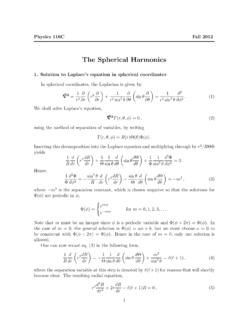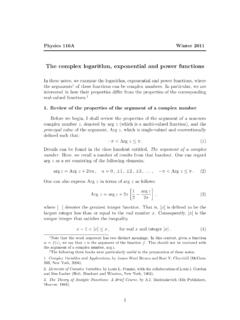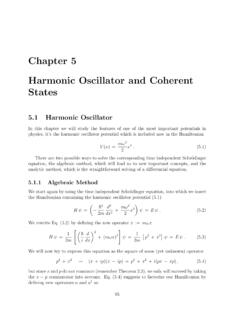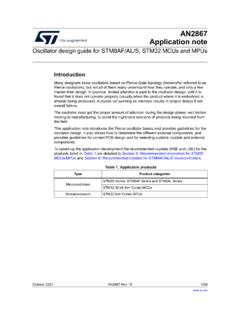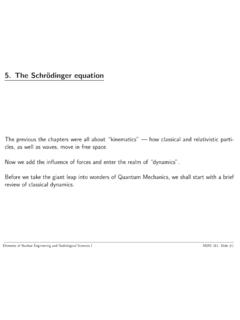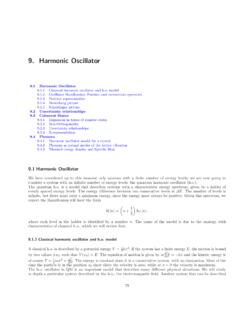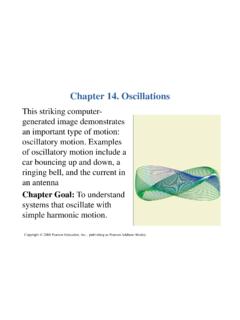Transcription of Solving the Simple Harmonic Oscillator
1 Physics 5 BWinter 2009 Solving the Simple Harmonic Oscillator1. The Harmonic Oscillator solution: displacement as a function of timeWe wish to solve the equation of motion for the Simple Harmonic Oscillator :d2xdt2= kmx ,(1)wherekis the spring constant andmis the mass of the oscillating body that isattached to the spring. We impose the following initial conditions on the 0, the initial displacement is denoted byx0and the corresponding velocityis denoted byv0. That is,x(t= 0) x0,anddxdt(t= 0) =v0.(2)These initial conditions then uniquely specify the method we shall employ for Solving this differential equation is called themethod of inspired guessing. In class, we argued that the motion of the oscillatingbody was periodic. Since the sine and cosine functions are periodic, we proposethe following solution for the displacementxas a function of the timet:x(t) =x0cos t+bsin t ,(3)whereband are to be determined. If we sett= 0, we findx(t= 0) =x0asrequired, so one of the two initial conditions is automatically satisfied.
2 The initialcondition for the velocity will determineb. That is, take the derivative of eq. (3)with respect tot. This yields:v(t) dxdt= x0sin t+ bcos t .(4)Settingt= 0 in eq. (4) then yieldsv0= b; henceb=v0 .(5)Thus, our proposed solution now has the following form:x(t) =x0cos t+v0 sin t.(6)This solution clearly satisfies the two initial conditions specified by eq. (2).1We have not yet proved that eq. (6) is in fact a solution to eq. (1). To do this,we compute the second derivative ofxwith respect tot. Taking two derivativesof eq. (6) with respect totyields:d2xdt2= 2x0cos t v0sin t= 2(x0cos t+v0 sin )= 2x .(7)Thus, we have verified thatd2xdt2= 2x .(8)Comparing with eq. (1), we conclude that 2=k/m, or = km.(9)2. The amplitude/phase form of the Harmonic Oscillator solutionGiancoli writes the solution to eq. (1) in another form:x(t) =Acos( t+ ),(10)whereAis a positive constant. Two questions immediately come to mind. First,why would one prefer a solution of the form of eq.
3 (10)? Second, is the solutiongiven by eq. (10) identical to the one given by eq. (6)? One advantage of eq. (10)is that it satisfies the inequality:|x(t)| A ,(11)which follows from the well known result|cos | 1. This allows us to immedi-ately identifyAas theamplitudeof the oscillation. The angle is called thephaseof the oscillation, and I will have more to say about this phase angle in section show that eqs. (10) and (6) are equivalent, we make use of the trigonometricidentity:cos( + ) = cos cos sin sin .(12)Identifying = tand = , we can rewrite eq. (10) as:x(t) =Acos tcos Asin tsin .(13)This result is precisely equivalent to eq. (6) if we identify:x0=Acos ,andv0 = Asin .(14)2 Thus, we have demonstrated that Giancoli s solution is equivalent to that ofeq. (6).3. The amplitudeAof the oscillatorWe can now use eq. (14) to relate the amplitudeAand the phase to theinitial conditions for the displacement and the velocity. Let us rewrite eq.
4 (14) as:cos =x0A,andsin = v0 A.(15)Using the trigonometric identity sin2 + cos2 = 1, it follows that:x20A2+v20 2A2= 1.(16)Cross-multiplying byA2, we can solve forA:A= x20+v20 2.(17)4. The phase of the oscillatorThe phase angle can be determined from eq. (15). However, there is a slightcomplication namely, is not uniquely defined, since I can add 2 to the phaseangle without changing any physical results. Thus, we say that the phase angles and +2 are equivalent, meaning that they lead to the same physical , I can establish a convention in which the value of is chosen to lie withinsome interval of length 2 . The most common convention is to choose suchthat: < .(18)That is, lies between 180 and 180 . Note that I have included one of theendpoints, , in the interval specified by eq. (18), but not the other endpoint .I have made this choice since the phase angle is equivalent to the phaseangle + 2 = (using the meaning of equivalent explained above).
5 It is tempting to divide the two equations given in eq. (15), which yields: tan sin cos = v0 x0.(19) Noting thatx(t) = cos( t+ ) = cos( t+ + 2 ) [ , the cosine is a periodic functionwith period 2 ], we wee that the phase angle and + 2 yield the same solution forx(t). Eq. (19) would seem to imply that = tan 1[v0/( x0)]. However, this form is notespecially convenient as the inverse tangent (also called the arctangent) is often defined to lie inan interval between /2 and /2. See the discussion following eq. (19).3 However, in doing so, we have lost some information, since changing the sign ofbothx0andv0changes the phase angle by but does not change the value oftan . This is not surprising since tan( + ) = tan , the tangent is a periodicfunction with period . The simplest way to avoid the ambiguity of eq. (19) is tonotice that eq. (15) implies that:v0<0= 0< < ,v0>0= < <0,v0= 0 andx0>0= = 0,v0= 0 andx0<0= = .(20)Then, eqs. (19) and (20) determine the phase angle uniquely within its definedinterval as specified by eq.
6 (18).The significance of the phase angle is that it determines by how much thedisplacement,x(t) =Acos( t+ ) leads or lags behind as compared to a purecosine curve,Acos t. The pure cosine curve has a maximum att= 0, whereasx(t) =Acos( t+ ) has a maximum when cos( t+ ) = 1. The latter implies thatthe maximum of the displacement closest to timet= 0 occurs when t+ = 0ort= / . If <0, then this maximum occurs for positivet, as shown infig. of Giancoli. In this case, we say that the phase ofx(t)lags behindthepure cosine curve, since we have to wait a positive time interval ( t= / infig. ) before reaching the maximum. If >0, then this maximum occurs fornegativet. In this case, the maximum has been achievedbeforethe maximum ofthe pure cosine curve; and thus the phase ofx(t)leadsthat of the pure Two Simple examplesWe review the two Simple examples introduced by Giancoli on page In the first example, we start the pendulum with zero velocity (v0= 0) ata displacementx0=A.
7 Indeed, eq. (17) confirms that forv0= 0 we havex0= is, for zero initial velocity the displacement of the pendulum att= 0 is theamplitude of the oscillation. Moreover, eq. (20) yields = 0 [note that eq. (19) isconsistent with this result]. Hence, eq. (10) yieldsx(t) =Acos t .(21)2. In the second example, we start the pendulum at its equilibrium point(x0= 0) with initial positive velocityv0>0. In this case, eq. (17) yieldsA=v0/ ,and eq. (20) implies that < <0. Finally, we use eq. (19) to conclude that = /2. Hence, eq. (10) yieldsx(t) =Acos( t 2)=Asin t .(22)4
